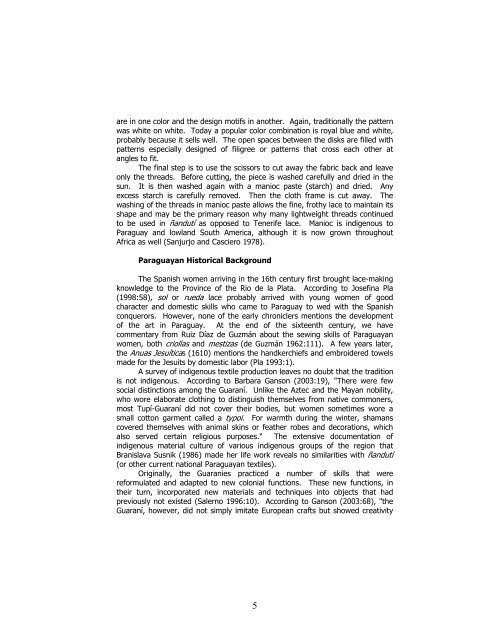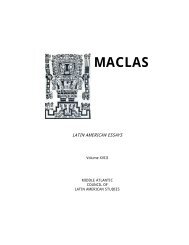latin american essays maclas
latin american essays maclas
latin american essays maclas
You also want an ePaper? Increase the reach of your titles
YUMPU automatically turns print PDFs into web optimized ePapers that Google loves.
are in one color and the design motifs in another. Again, traditionally the pattern<br />
was white on white. Today a popular color combination is royal blue and white,<br />
probably because it sells well. The open spaces between the disks are filled with<br />
patterns especially designed of filigree or patterns that cross each other at<br />
angles to fit.<br />
The final step is to use the scissors to cut away the fabric back and leave<br />
only the threads. Before cutting, the piece is washed carefully and dried in the<br />
sun. It is then washed again with a manioc paste (starch) and dried. Any<br />
excess starch is carefully removed. Then the cloth frame is cut away. The<br />
washing of the threads in manioc paste allows the fine, frothy lace to maintain its<br />
shape and may be the primary reason why many lightweight threads continued<br />
to be used in ñandutí as opposed to Tenerife lace. Manioc is indigenous to<br />
Paraguay and lowland South America, although it is now grown throughout<br />
Africa as well (Sanjurjo and Casciero 1978).<br />
Paraguayan Historical Background<br />
The Spanish women arriving in the 16th century first brought lace-making<br />
knowledge to the Province of the Rio de la Plata. According to Josefina Pla<br />
(1998:58), sol or rueda lace probably arrived with young women of good<br />
character and domestic skills who came to Paraguay to wed with the Spanish<br />
conquerors. However, none of the early chroniclers mentions the development<br />
of the art in Paraguay. At the end of the sixteenth century, we have<br />
commentary from Ruiz Díaz de Guzmán about the sewing skills of Paraguayan<br />
women, both criollas and mestizas (de Guzmán 1962:111). A few years later,<br />
the Anuas Jesuíticas (1610) mentions the handkerchiefs and embroidered towels<br />
made for the Jesuits by domestic labor (Pla 1993:1).<br />
A survey of indigenous textile production leaves no doubt that the tradition<br />
is not indigenous. According to Barbara Ganson (2003:19), "There were few<br />
social distinctions among the Guaraní. Unlike the Aztec and the Mayan nobility,<br />
who wore elaborate clothing to distinguish themselves from native commoners,<br />
most Tupí-Guaraní did not cover their bodies, but women sometimes wore a<br />
small cotton garment called a typoi. For warmth during the winter, shamans<br />
covered themselves with animal skins or feather robes and decorations, which<br />
also served certain religious purposes." The extensive documentation of<br />
indigenous material culture of various indigenous groups of the region that<br />
Branislava Susnik (1986) made her life work reveals no similarities with ñandutí<br />
(or other current national Paraguayan textiles).<br />
Originally, the Guaranies practiced a number of skills that were<br />
reformulated and adapted to new colonial functions. These new functions, in<br />
their turn, incorporated new materials and techniques into objects that had<br />
previously not existed (Salerno 1996:10). According to Ganson (2003:68), "the<br />
Guaraní, however, did not simply imitate European crafts but showed creativity<br />
5




